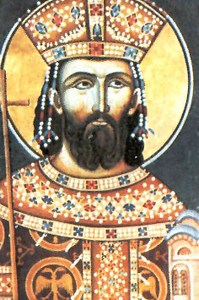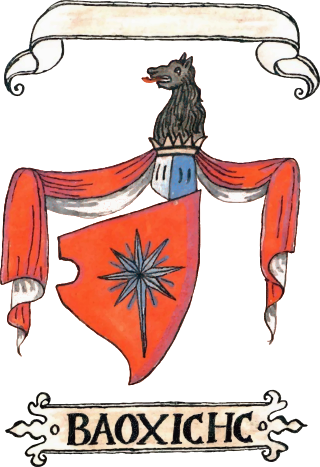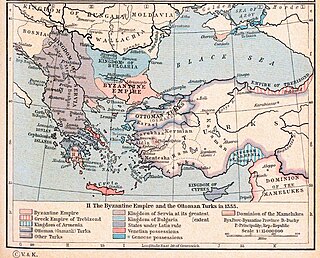| History of Montenegro |
|---|
 |
| Prehistory |
| Middle Ages and early modern |
| Modern and contemporary |
| Topics |
This is a list of princes of Zeta.
| History of Montenegro |
|---|
 |
| Prehistory |
| Middle Ages and early modern |
| Modern and contemporary |
| Topics |
This is a list of princes of Zeta.
After Constantin Bodin's death, fighting among his potential successors weakened the state of Duklja and the region succumbed to Rascia's reign between 1183 and 1186.
In 1190, Grand Župan of Rascia Stefan Nemanja's son, Vukan II, asserted his right to the Dukljan crown. In 1219, the regent of Zeta and King Vukan's oldest son, Đorđe Nemanjić, became king of Duklja/Zeta. He was succeeded by his second oldest son, Uroš I, who built the 'Uspenje Bogorodice' monastery in Morača.
Between 1276 and 1309, Zeta was ruled by Queen Jelena, widow of Serbia's King Uroš I. She restored around 50 monasteries in the region--- most notably Saint Srđ and Vakh on the Bojana River. The name Crna Gora (Montenegro) was formally mentioned for the first time in 1296, in the charter of St. Nicholas' monastery in Vranjina. This charter was issued by the Serbian King Stefan Milutin Nemanjić, who was the youngest son of Uroš I and Helen of Anjou. Crna Gora (Montenegro) was to be understood as the highland region under Mount Lovćen, within the confines of Zeta. By the beginning of the 14th century, during King Milutin's reign, the Archdiocese in Bar was the strongest feudal lord in Zeta.
From 1309 to 1321, Zeta was co-ruled by the oldest son of King Milutin, Young King Stefan Uroš III Dečanski. Similarly, from 1321 to 1331, Stefan's young son Stefan Dušan Uroš IV Nemanjić, the future Serbian King and Tsar, co-ruled Zeta with his father.
After Tsar Dušan's death in 1355, the Serbian state Kingdom started to crumble and its holdings were divided among Prince (Knjaz) Lazar Hrebeljanović, the short-lived (1353–1391) Bosnian state of Tvrtko I Kotromanić, and a semi-independent chiefdom of Zeta under the House of Balšić, whose founder Balša I came to power in 1356.

The Principality of Zeta (Serbian : Кнежевина Зета, romanized: Kneževina Zeta) is a historiographical name for a late medieval Serbian principality located in the southern parts of modern Montenegro and northern parts of modern Albania, around the Lake of Skadar. It was ruled by the Serbian families of Balšić, Lazarević, Branković and Crnojević in succession from the second half of the 14th century until Ottoman conquest at the very end of the 15th century. Previously, the same region of Zeta was a Serbian crown land, that had become independent after the fall of the Serbian Empire, when the Balšić family created a regional principality, sometime after 1360. [1]
The region of Zeta was a part of the Serbian Empire reigned by the House of Nemanjić. In the mid-14th century in the Lower Zeta region, a minor nobility family known as the House of Balšić comes to prominence (during the reign of Tsar Dušan; ca. 1360 they have become one of the major nobility groups within the Empire, recognized as such local lords of Zeta under Tsar Uroš. The Serbian Empire becomes ever-fragmented as local lords become acting ever-more independently, the Balšićs included; after the Battle of Marica in 1371 emperor Uroš dies and no one succeeds him at the Throne.
In 1421 the Balšić family is succeeded by the House of Lazarević.
The Balšić family members all had their own lands which they held collectively, but they were at various times presided by a Head of the Family:
In 1427 the Serbian despot died and the throne through adoptive lineage passes on to the House of Branković, according to the treaty; they inherit the Zetan territories. The Lazarevic and Brankovic houses use the legitimate right they had succeeded from the Balsics in order to claim supremacy over the Crnojevic house as well, in the Upper Zeta region (Montenegro proper).
In 1456 the last Serbian bastion in Zeta, the fortifications of Medun, are conquered by the Ottoman forces of Sultan Mehmed the Conqueror.
The House of Crnojević was a dynasty ruling in the Medieval state of Zeta, first struggling with House of Balšić for control over Zeta, and then succeeding them as Zeta's supreme overlords throughout the 14th and 15th century. Since the second half of the 15th century, they would play a crucial role in the survival of late Medieval Zeta. All members of the House of Crnojević considered themselves Lords Zetan.
| Name | Reign | Territory | Notes |
|---|---|---|---|
| Radič | end of the 14th century–1396 | Zeta | |
| Đurađ Đurašević and Aleksa Đurašević | 1403–1435 | Zeta | Ruled as vassals of the Venetians |
| Gojčin (Gojčin, Goycinus) | 1435–1451 | Zeta | Ruled under Đurađ Branković ( Serbian Despotate ) |
| Stefan I | 1451–1465 | Zeta | Ruled under the Despotate 1451–1452, then under Venetian rule |
| Ivan I | 1465–1490 | Zeta | |
| Đurađ IV | 1490–1496 | Zeta | |
| Stefan II | 1496–1499 | Zeta | Nominal ruler under Ottoman suzerainty |

Lazar Hrebeljanović was a medieval Serbian ruler who created the largest and most powerful state on the territory of the disintegrated Serbian Empire. Lazar's state, referred to by historians as Moravian Serbia, comprised the basins of the Great Morava, West Morava, and South Morava rivers. Lazar ruled Moravian Serbia from 1373 until his death in 1389. He sought to resurrect the Serbian Empire and place himself at its helm, claiming to be the direct successor of the Nemanjić dynasty, which went extinct in 1371 after ruling over Serbia for two centuries. Lazar's programme had the full support of the Serbian Orthodox Church, but the Serbian nobility did not recognize him as their supreme ruler. He is often referred to as Tsar Lazar Hrebeljanović ; however, he only held the title of prince.

Đurađ Vuković Branković was the Serbian Despot from 1427 to 1456. He was one of the last Serbian medieval rulers. He was a participant in the battle of Ankara (1402) and Ottoman Interregnum (1403–1413). During his reign, the despotate was a vassal of both Ottoman sultans as well as Hungarian kings. Despot George was neutral during the Polish-Lithuanian (1444) and Hungarian-Wallachian (1448) crusades. In 1455, he was wounded and imprisoned during clashes with the Hungarians, after which the young Sultan Mehmed II launched the siege of Belgrade and its large Hungarian garrison. Despot Đurađ died at the end of 1456, due to complications stemming from the wound. After his death, Serbia, Bosnia and Albania became practically annexed by sultan Mehmed II, which only ended after centuries of additional conquests of Byzantine lands. Đurađ attained a large library of Serbian, Slavonic, Latin, and Greek manuscripts. He made his capital Smederevo a centre of Serbian culture. He was the first of the Branković dynasty to hold the Serbian monarchy.

The Serbian Despotate was a medieval Serbian state in the first half of the 15th century. Although the Battle of Kosovo in 1389 is mistakenly considered the end of medieval Serbia, the Despotate, a successor of the Serbian Empire and Moravian Serbia, lasted for another sixty years, experiencing a cultural, economic, and political renaissance, especially during the reign of Despot Stefan Lazarević. After the death of Despot Đurađ Branković in 1456, the Despotate continued to exist for another three years before it finally fell under Ottoman rule in 1459.

The House of Balšić, or Balsha, were a noble family that ruled "Zeta and the coastlands", from 1362 to 1421, during and after the fall of the Serbian Empire. Balša, the founder, was a petty nobleman who held only one village during the rule of Emperor Dušan the Mighty, and only after the death of the emperor, his three sons gained power in Lower Zeta after acquiring the lands of gospodin Žarko under unclear circumstances, and they then expanded into Upper Zeta by murdering voivode and čelnik Đuraš Ilijić. Nevertheless, they were acknowledged as oblastni gospodari of Zeta in edicts of Emperor Uroš the Weak. After the death of Uroš (1371), the family feuded with the Mrnjavčevići, who controlled Macedonia.

The House of Crnojević was a medieval Serbian noble family that held Zeta, or parts of it; a region north of Lake Skadar corresponding to southern Montenegro and northern Albania, from 1326 to 1362 CE, then 1403 until 1515.

Đurađ I Balšić, or Gjergj Balsha I was the Lord of Zeta between 1362 and 13 January 1378. He was the eldest of the three sons of Balša I, and belonged to the Balšić family.

Đurađ II Balšić, or Gjergj Balsha IIfl. 1385 – April 1403), was the Lord of Zeta from 1385 to 1403, as a member of the Balšić noble family. He was the son of Stracimir Balšić, and succeeded his paternal uncle Balša II in ruling Zeta. He reigned from 1386 up to 1389 in the still officially undissolved Serbian Empire in the form of a family alliance, then up to 1395 as an Ottoman vassal. He ruled until his death in 1403, when he was succeeded by his only son, Balša III. He is known in Serbian epic poetry as Strahinja Banović.

The House of Lazarević was a Serbian medieval royal family, which ruled Moravian Serbia and the Serbian Despotate.

Nemanjić family tree
Helen, Helena or Jelena of Serbia may refer to the following Serbian consorts:
Stefan or Stephan is a masculine given name, a form of the English name Stephen.

Zeta was one of the medieval polities that existed between 1356 and 1421, whose territory encompassed parts of present-day Montenegro and northern Albania, ruled by the Balšić family from 1356.
In the medieval Serbian states, the privileged class consisted of nobility and clergy, distinguished from commoners, part of the feudal society. The Serbian nobility were roughly grouped into magnates, the upper stratum, and the lesser nobility (vlasteličići). Serbia followed the government model established by the Byzantine Empire.

The fall of the Serbian Empire was a decades-long process in the late 14th century. Following the death of the childless Emperor Stefan Uroš V in 1371, the Empire was left without an heir and the magnates, velikaši, obtained the rule of its provinces and districts, continuing their offices as independent with titles such as gospodin, and despot, given to them during the Empire. This period is known as the dissolution or the beginning of the fall of the Serbian Empire.

Zeta as a crown land was a medieval region and province of the Serbian state of the Nemanjić dynasty, from the end of the 12th century, up to the middle of the 14th century. During that period, regional administration in Zeta was often bestowed to various members of the ruling dynasty, who administered the region as a crown land.

Zeta was one of the Serbian medieval polities that existed between 1356 and 1496, whose territory encompassed parts of present-day Montenegro and northern Albania. The Crnojević noble family ruled the Zeta from 1451 until 1496. The state included parts of modern Montenegro and parts of modern Albania.

The Second Scutari War was an armed conflict in 1419–1426 between Zeta (1419–1421) and then the Serbian Despotate (1421–1423) on the one side and the Venetian Republic on the other, over Scutari and other former possessions of Zeta captured by Venice.
Jelena Lazarević, also known, by marriages, as Jelena Balšić or Jelena Hranić or Jelena Kosača, was a medieval Serbian princess, daughter of Prince Lazar of Serbia and Princess Milica Nemanjić. She had a very strong personality and significantly influenced the way her husbands, first Đurađ II Balšić and second Sandalj Hranić Kosača, and her son Balša III governed their realms. Jelena encouraged them to resist Venetian encroachment on territory belonging to Zeta, the medieval Serbian state ruled by Đurađ II and then by Balša III after Đurađ II's death. She is also known as a writer in epistolary literature, particularly her correspondence with Nikon of Jerusalem, a monk in the Gorica monastery on Lake Skadar (Montenegro). Her three epistles are part of the Gorički zbornik, a medieval manuscript collection.
Stefan Balšić ; fl. 1419-40), known as Stefan Maramonte, was a Zetan nobleman. He was the son of Konstantin Balsha and Helena Thopia. After Konstantin's death (1402), Helena entered the Republic of Venice and then lived with her sister Maria. Since Maria was married to Philip Maramonte, the Venetians and Ragusans often referred to Stefan Balsha with the name Maramonte. He was initially a close associate to Zetan lord Balša III, being his vassal. Balsha III and Stefan fought against the Republic of Venice, and Stefan helped in the administration of the land as co-ruler with Balsha III, he did however not succeed Balša III. Balša III, who died on 28 April 1421, had decided to pass the rule of Zeta to his uncle, the Serbian Despot Stefan Lazarević. When the Second Scutari War between Venice and Despot Stefan began, he [...]. Stefan left Apulia in the summer of 1426, seeking to take Zeta. During the 1427–28 conflict, Maramonte went to the Ottoman court where he sought the support of Sultan Murad II for his appointment as the Lord of Zeta. There, he met Skanderbeg, who was a hostage at the Ottoman court. Maramonte married Vlajka Kastrioti, the sister of Skanderbeg. Supported by the Ottomans, Maramonte, accompanied by Gojčin Crnojević and Little Tanush, plundered the region around Scutari and Ulcinj, and attacked Drivast in 1429, but failed to capture it. Since his attempts failed, Maramonte surrendered to the Venetians and served as their military officer in the campaigns in Flanders and Lombardia.